If I had to choose my second favorite ingredient (you can guess what the first one is from the name of this blog), it would have to be
herbs. I am much more of an herb person than a spice person. I guess it comes with the territory when you grow up in Eastern Europe and learn how to cook in the Mediterranean. I don't toast and grind my own spices, and I probably couldn't tell you the difference between two types of chilies. But when it comes to herbs, I am fanatical. I never met an herb I didn't like, and at any given moment I am likely to have
3-4 varieties of fresh herbs in my fridge. If I don’t have an herb the recipe calls for, I substitute, but under no circumstances do I use dried herbs. It’s like using garlic powder instead of real garlic – it’s just not the same thing. When I teach classes, I get all kinds of interesting questions about herbs and I thought I'll finally sit down and organize my thoughts on the topic of herbs.
Q: How do you wash herbs?
A: I use a
salad spinner
. Believe it or not I bought it just for that purpose. I mean, who washes salads these days when you can buy pre-washed mixed greens?
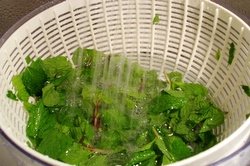
Before I bought a salad spinner, I filled a large bowl with cold water and let the herbs soak for 5 minutes allowing the
sand to settle on the bottom. Then I would scoop them out (being careful not to disturb the sand) and lay them out on
paper towels to dry.
Q: How do you keep herbs fresh?
A: After washing herbs, and drying most of the water off them (that’s when the spinner comes in handy), I wrap them in a dry paper towel and stuff them in
zip lock bags. Since I have several such bags in my fridge at one time, I write the herb and date on the bag to help me figure out which is which. Wrapped this way, the herbs stay fresh at least
1 week.
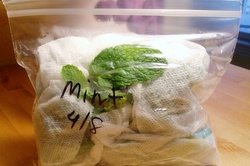 Q: What’s the best time to add herbs to your dish?
Q: What’s the best time to add herbs to your dish?
A: All herbs are split into two categories:
hard herbs and
soft herbs. I never heard those terms used in culinary literature, so I am not sure if those are technical definitions or if I just made them up, but it’s distinctions that I find useful.
Hard herbs, like
rosemary, sage and thyme are sturdy and I add them to my dishes in the
beginning of cooking.
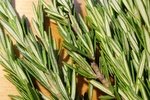 Soft herbs
Soft herbs, like
parsley, cilantro, mint, dill, and chives are delicate and turn brown and yucky when cooked. I add them in the last minute of cooking time, or
after taking the dish of the heat.
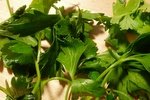 Q: Most dishes call for just a few sprigs of a particular herb. What do you do with the rest of the bunch?
Q: Most dishes call for just a few sprigs of a particular herb. What do you do with the rest of the bunch?
A: If I have
soft herb leftovers, I often make a
pesto type dip for bread. These little sauces take 5 minutes to make in a food processor and are excellent on top of fish, chicken, and lamb. They also are perfect for mixing into pasta or serving as a spread for sandwiches. The possibilities are endless if you use your imagination.
Here are some ideas to get you started:
Basil Pesto:
Basil, Pine nuts, parmesan, garlic, olive oil, butter (
recipe)
Mint-Pistachio Pesto:
Mint, Pistachios, garlic, olive oil
Maidanosalata (Greek parsley spread):
Parsley, garlic, lemon juice, 1 piece of bread without crust, olive oil
Salsa Verde:
Parsley and some other herb of your choice, lemon zest and juice, capers, anchovy, olive oil (
recipe)
Cilantro-Lime Sauce:
Cilantro, lime zest and juice, garlic, olive oil
You don’t really need measurements for these sauces. Just be conservative with the garlic.
One or even half a clove is all you need. Start by processing the herbs with the other ingredients, except for olive oil. When everything is well chopped, keep the food processor running, and drizzle in enough olive oil to form a paste that is as thick or thin as you’d like.
You can also make
chive, parsley, or mint oil by combining the appropriate herb with some olive oil in a
blender instead of a food processor and pureeing until completely smooth. Drizzle some of this great stuff over your plate and you can turn any weekday dinner into a restaurant quality meal.
When I have
hard herbs leftover, I often throw a bunch on the
grill when cooking fish or meat. The smell is intoxicating and in makes whatever you are cooking extremely aromatic. You can also cook hard herbs like
rosemary or
oregano in olive oil on very low heat to
infuse it with that herb’s flavor.
Sage leaves are awesome pan-fried in a few tablespoons of
butter until
crispy and then stirred into
pasta or
gnocchi (along with all that deliciously infused butter, of course).
So, what are you waiting for? I am sure you have some herbs in your fridge that can be turned into something yummy instead of languishing in anonymity until they wilt. Have fun!








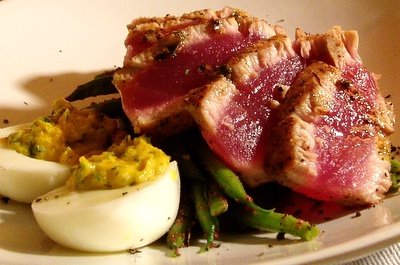
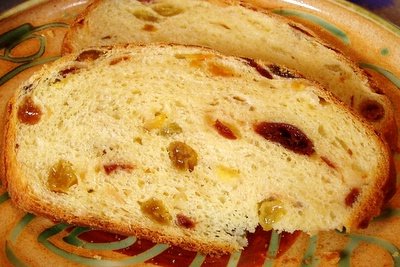 There are 3 types of people in this world (at least among the inhabitants of the kitchen): the cooks, the bakers, and the bread bakers.
There are 3 types of people in this world (at least among the inhabitants of the kitchen): the cooks, the bakers, and the bread bakers.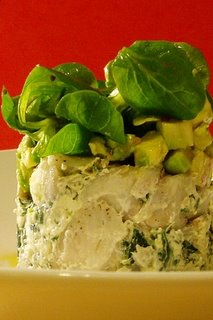 Happy Passover and Easter to all my dear blog readers!
Happy Passover and Easter to all my dear blog readers!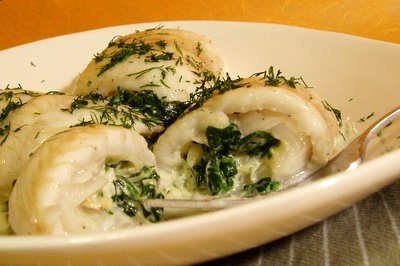

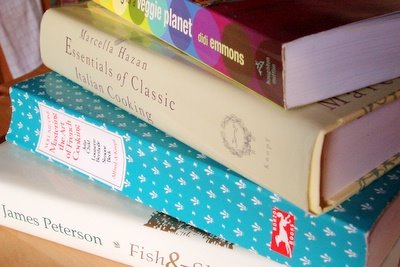 Couple of weeks go, my fellow food blogger, Ivonne from
Couple of weeks go, my fellow food blogger, Ivonne from  I have recently discovered the most wonderful blog --
I have recently discovered the most wonderful blog -- 
 I recently took a food photography seminar at BU. "Oh really?" you say. What? You mean it doesn't show? Didn't you notice my cool new background? Ok, I admit, I have a long way to go, but compared to the
I recently took a food photography seminar at BU. "Oh really?" you say. What? You mean it doesn't show? Didn't you notice my cool new background? Ok, I admit, I have a long way to go, but compared to the